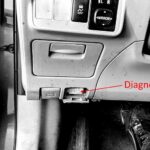Swapping engines in your 92-00 Honda Civic can breathe new life into your ride, and the D16Y8 VTEC engine is a popular choice for those seeking a performance boost. This guide focuses on the wiring aspects of swapping a D16Y8 OBD2 engine into various 92-00 Civic models, addressing common questions and potential challenges, particularly concerning the crankshaft position sensor (CKF) and compatibility with different OBD systems. Whether you’re upgrading from a non-VTEC engine or navigating the complexities of OBD2 to OBD1 conversions, this guide will provide the essential wiring information you need for a successful D16Y8 swap.
Understanding OBD Systems and Engine Swaps
Before diving into the specifics of wiring, it’s crucial to understand the different On-Board Diagnostics (OBD) systems and how they affect engine swaps in 92-00 Civics. These models span across OBD1 and OBD2 generations, each with distinct engine control units (ECUs) and sensor requirements. Engine swaps often involve mixing OBD generations, requiring careful attention to wiring to ensure compatibility and proper engine function.
The D16Y8 engine, originating from 96-00 Civics, is an OBD2 system. When swapping it into an older OBD1 Civic (92-95) or even into an OBD2 Civic originally equipped with a non-VTEC engine (like the D16Y7), wiring adjustments are necessary. One key component in OBD2 systems is the crankshaft position sensor, also known as the CKF sensor. This sensor plays a vital role in engine management by providing crucial data about the crankshaft’s position and speed.
D16Y8 into OBD1 Civic (92-95) Wiring
Swapping a D16Y8 OBD2 engine into a 92-95 OBD1 Civic is a common modification. Here’s a breakdown of the wiring considerations when using a P28 OBD1 ECU, a popular choice for managing this swap:
Base Models: DX, LX, CX (D15B7, D15B8)
For DX, LX, and CX models originally equipped with non-VTEC engines like the D15B7 or D15B8, the swap to a D16Y8 requires wiring for VTEC engagement. These models will need manual wiring of the VTEC solenoid and VTEC pressure switch to the P28 ECU.
Figure 1: OBD1 ECU Wiring Diagram. This diagram illustrates the necessary wiring connections for integrating VTEC and other components when using an OBD1 ECU in a 92-95 Civic.
Key Wiring Tasks:
- VTEC Wiring: Connect the VTEC solenoid and pressure switch to the appropriate pins on the P28 ECU as shown in wiring diagrams (like Figure 1).
- Distributor: The D16Y8 distributor may not directly bolt onto earlier Civic models. You can either use the distributor from your original engine (e.g., D15B7, D15B8) or utilize an OBD2A or OBD2B to OBD1 distributor adapter harness to use the D16Y8 distributor.
- Intake Air Temperature (IAT) Sensor: The D16Y8 intake manifold does not have a provision for the IAT sensor. You’ll need to relocate your IAT sensor to the intake arm. Alternatively, you can use the intake manifold from your original engine (D15B7/D15B8), which will bolt onto the D16Y8 head.
Figure 2: OBD1 IAT Sensor Relocation. This image shows an example of relocating the Intake Air Temperature (IAT) sensor into the intake arm, necessary when swapping to a D16Y8 engine in OBD1 Civics.
- Injectors: Reuse your original injectors (e.g., D15B7/D15B8 injectors) as the D16Y8 injectors may not plug in correctly to the OBD1 harness. DX injectors are generally the same flow rate as D16Y8 injectors, while CX models might benefit from upgrading to EX/SI/DX injectors for better fuel delivery with the D16Y8.
- Alternator: Reuse your original alternator (e.g., D15B7/D15B8 alternator) as the D16Y8 alternator uses a different plug style.
- Crankshaft Position Sensor (CKF): The D16Y8 engine has a CKF sensor located by the crankshaft. However, when using a P28 OBD1 ECU, this sensor is not utilized. You should securely tie the CKF sensor wiring out of the way and do not connect it to the OBD1 ECU. The OBD1 system does not rely on a CKF sensor in the same way OBD2 does for basic operation.
EX, Si, VX (D16Z6, D15Z1)
For EX, Si, and VX models, which already have VTEC (D16Z6, D15Z1), the VTEC wiring is generally plug-and-play when using a 92-95 EX/Si engine harness, as VTEC wiring is pre-run to the ECU harness in these models.
Wiring Considerations:
- VTEC: VTEC solenoid and pressure switch wiring should be plug and play with an EX/SI harness.
- IAT Sensor, Distributor, Injectors, Alternator, CKF Sensor: Follow the same instructions as for DX/LX/CX models regarding the IAT sensor relocation, distributor compatibility, injector and alternator reuse, and the non-utilization of the D16Y8 crankshaft position sensor when using a P28 ECU.
VX Model Specifics
VX models (D15Z1) may have a 7-wire O2 sensor. If this is the case, you’ll need to convert it to a 4-wire O2 sensor system, as detailed in online resources like hybridautomotive.com.
D16Y8 into OBD2 Civic (96-00) Wiring
Swapping a D16Y8 engine into a 96-00 OBD2 Civic is generally more straightforward, especially if the original Civic already had a D-series engine. However, wiring might still be necessary depending on the original model and the specific ECU being used.
Upgrading Non-VTEC (D16Y7) to VTEC (D16Y8)
For DX, LX, and CX models (D16Y7) upgrading to a D16Y8 within the OBD2 system, wiring the VTEC components is essential.
Wiring Tasks (using P2P OBD2 ECU):
- VTEC Wiring: You will need to wire in the VTEC solenoid and VTEC pressure switch. Refer to wiring diagrams for OBD2A (96-98) and OBD2B (99-00) Civics (Figures 6 & 7 in the original article, or readily available online).
- Idle Air Control Valve (IACV): The D16Y7 uses a 3-wire IACV, while the D16Y8 uses a 2-wire IACV. Wiring conversion is required. Again, consult OBD2A and OBD2B wiring diagrams for correct connections (Figures 6 & 7).
- Secondary O2 Sensor: If using an EX-style catalytic converter, you may need to extend the secondary O2 sensor wiring using an O2 sensor adapter.
- IAT Sensor: Relocate the IAT sensor to the intake arm, similar to the OBD1 swap.
Figure 3: OBD2 IAT Sensor Relocation. This image demonstrates relocating the Intake Air Temperature (IAT) sensor for OBD2 Civics when the intake manifold doesn’t have a designated location.
- Knock Sensor: Wire in the knock sensor, as the D16Y8 and P2P ECU utilize this sensor.
- Crankshaft Position Sensor (CKF): The D16Y8 CKF sensor is used when retaining the OBD2 P2P ECU. Ensure it is properly connected as part of the OBD2 engine harness.
HX Models (D16Y5)
HX models (D16Y5) are mostly plug-and-play when swapping to a D16Y8 within OBD2. VTEC solenoid and pressure switch wiring are reused. 5-speed HX models may require wiring for the knock sensor, as only CVT models originally had knock sensors. HX models may also have a 7-wire O2 sensor that needs conversion to a 4-wire system, similar to VX models in OBD1 swaps.
Crankshaft Position Sensor (CKF) and OBD2 vs. OBD1
The primary difference in CKF sensor usage between OBD1 and OBD2 swaps with the D16Y8 lies in the ECU.
-
OBD1 (P28 ECU): When using an OBD1 P28 ECU to manage a D16Y8 engine, the CKF sensor is not compatible or used. The P28 ECU is not designed to process the CKF sensor signal. Therefore, you should leave the D16Y8 CKF sensor disconnected and secured out of the way. The engine will run without it when controlled by the P28.
-
OBD2 (P2P ECU): When using an OBD2 P2P ECU (the ECU designed for the D16Y8), the CKF sensor is essential and must be connected. The OBD2 system relies on the CKF sensor for precise crankshaft position and speed data, which is critical for fuel and ignition timing, and overall engine management.
Why the Difference?
OBD2 systems are more sophisticated and emissions-focused than OBD1. The CKF sensor is part of the enhanced diagnostic and control capabilities of OBD2. OBD1 systems, while capable, are simpler and do not incorporate the CKF sensor into their core engine management strategy.
Conclusion
Successfully swapping a D16Y8 engine into a 92-00 Honda Civic involves careful wiring considerations, especially when crossing OBD generations. Understanding the role, or lack thereof, of the crankshaft position sensor in OBD1 versus OBD2 setups is crucial for a smooth and functional swap. By following this guide and consulting relevant wiring diagrams, you can confidently tackle the wiring aspects of your D16Y8 engine swap, ensuring your Civic is back on the road with enhanced VTEC performance. Remember to always double-check wiring connections and consult professional resources if you encounter any uncertainties during your engine swap project.

